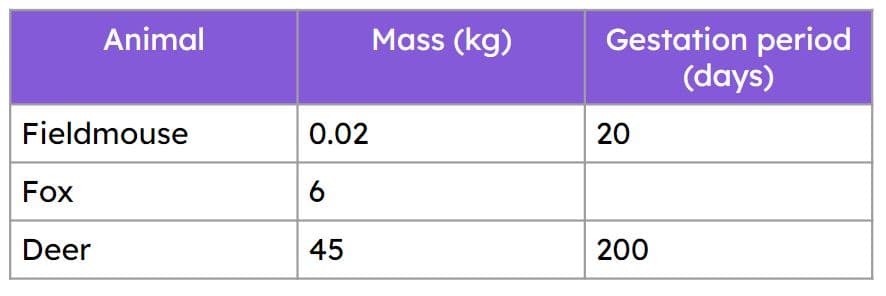Myths about teaching can hold you back
- Year 5
Animal gestation periods
I can use information to predict the gestation periods of different animals.
- Year 5
Animal gestation periods
I can use information to predict the gestation periods of different animals.
These resources will be removed by end of Summer Term 2025.
Switch to our new teaching resources now - designed by teachers and leading subject experts, and tested in classrooms.
These resources were created for remote use during the pandemic and are not designed for classroom teaching.
Lesson details
Key learning points
- Gestation is the period of time that an animal carries its offspring inside its body before giving birth.
- Patterns can be found in the gestation periods of different animals.
- Larger animals tend to have longer gestation periods (as they tend to produce larger offspring).
- Scientists can use patterns in their results to make predictions for further investigations.
- The gestation periods of different animals can be found out by observing them or by carrying out research.
Keywords
Animal - An animal is a living thing which moves and eats other animals or plants.
Offspring - Living things create offspring when they reproduce.
Gestation period - A gestation period is the amount of time an animal carries its offspring inside its body before giving birth.
Prediction - A prediction is a statement saying what you think will happen.
Research - To research something is to find out about it or investigate it carefully.
Common misconception
Pupils may think that humans are not animals.
Explain that humans are animals and are part of the mammal group. Make clear the characteristics we have that mean we fit into this group.
To help you plan your year 5 science lesson on: Animal gestation periods, download all teaching resources for free and adapt to suit your pupils' needs...
To help you plan your year 5 science lesson on: Animal gestation periods, download all teaching resources for free and adapt to suit your pupils' needs.
The starter quiz will activate and check your pupils' prior knowledge, with versions available both with and without answers in PDF format.
We use learning cycles to break down learning into key concepts or ideas linked to the learning outcome. Each learning cycle features explanations with checks for understanding and practice tasks with feedback. All of this is found in our slide decks, ready for you to download and edit. The practice tasks are also available as printable worksheets and some lessons have additional materials with extra material you might need for teaching the lesson.
The assessment exit quiz will test your pupils' understanding of the key learning points.
Our video is a tool for planning, showing how other teachers might teach the lesson, offering helpful tips, modelled explanations and inspiration for your own delivery in the classroom. Plus, you can set it as homework or revision for pupils and keep their learning on track by sharing an online pupil version of this lesson.
Explore more key stage 2 science lessons from the Reproduction and life cycles: animals unit, dive into the full primary science curriculum, or learn more about lesson planning.

Equipment
Access to the internet for research (optional)
Content guidance
- Risk assessment required - equipment
Supervision
Adult supervision required
Licence
Prior knowledge starter quiz
6 Questions
Q1.Which of these animal types give birth to live young?
Q2.Which of these is not a mammal?
Q3.What are an animal’s offspring?
Q4.Which of these words means to find out more about something by using other sources of information?
Q5.When animals make more of the same type of animal, it is called .
Q6.When scientists say what they think will happen in an investigation, it is called a .
Assessment exit quiz
6 Questions
Q1.When an animal is growing inside its mother’s body, it is called a period.
Q2.Which of these animals is likely to have the shortest gestation period?
Q3.Which of these animals would not spend time gestating inside its mother’s body?
Q4.Starting with the longest, order these animals according to the length of their gestation period.
Q5.Look at the table. What would be a sensible prediction for the gestation period of a fox?



